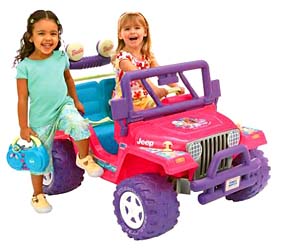Barbie Take Along Tunes Jeep
Power Wheels Barbie Take Along Tunes Jeep by Fisher Price
 A restage of the Barbie Crusin Tunes Jeep 4 x 4. This is a 12 volt BPRO for the advanced series that goes 2-5 mph forward and 2.5 in reverse. Main feature of this restage is the portable Boom Box that can be taken out of the vehicle. The boom box comes with 6 CD's of different musical themes, along with pretend radio stations featuring DJ Barbie. New brushguard, rollbar and windshield give the vehicle an exciting new feel. Graphics and colors are being updated to keep this popular item looking fresh.
A restage of the Barbie Crusin Tunes Jeep 4 x 4. This is a 12 volt BPRO for the advanced series that goes 2-5 mph forward and 2.5 in reverse. Main feature of this restage is the portable Boom Box that can be taken out of the vehicle. The boom box comes with 6 CD's of different musical themes, along with pretend radio stations featuring DJ Barbie. New brushguard, rollbar and windshield give the vehicle an exciting new feel. Graphics and colors are being updated to keep this popular item looking fresh.
Evolution of Batteries in Children's Vehicles: From 12V Alkaline to Advanced Types
Children's battery-operated vehicles, such as those from the Power Wheels line, have experienced significant advancements in their battery technology over the years. These enhancements have led to improved performance, longer run times, faster charging, and overall better experiences for young drivers. Here's a look at this evolution:
- Initial 12V Alkaline Batteries: The early battery-operated vehicles for children used 12V alkaline batteries. These batteries were relatively large and heavy. They provided decent power for the vehicles, but their main drawbacks were limited run time, relatively slow charging, and the eventual need for replacement, given the non-rechargeable nature of many alkaline batteries.
- Sealed Lead-Acid (SLA) Batteries: As the technology advanced, many children's vehicles started using sealed lead-acid batteries. These batteries were rechargeable, reducing the overall operating cost for parents. SLA batteries are heavier, but they offered better performance and longer life cycles compared to alkaline batteries. However, they still had the limitation of gradual loss of charge capacity over time and required regular charging to maintain their lifespan.
- Nickel-Cadmium (NiCd) Batteries: NiCd batteries were the next step in the evolution, offering a lighter weight option compared to SLA batteries. They had a good energy density, meaning they could provide power for a longer time without increasing the battery's size. However, they suffered from the "memory effect," where if they were frequently charged without being fully discharged, they could lose their maximum energy capacity.
- Nickel-Metal Hydride (NiMH) Batteries: NiMH batteries were an improvement over NiCd batteries. They retained the benefits of NiCd but had a higher energy density and were less prone to the memory effect. They also contained fewer toxic metals, making them more environmentally friendly.
- Lithium-Ion (Li-ion) and Lithium-Polymer (LiPo) Batteries: These are the latest advancements in battery technology for children's vehicles. Li-ion and LiPo batteries are much lighter than their predecessors, have an even higher energy density, and can deliver more power. They can also be rapidly charged and do not suffer from the memory effect. Moreover, they provide consistent power output, meaning the vehicle won't slow down as the battery discharges. Their primary drawback is that they can be more expensive, but their benefits often outweigh this cost difference.
The progression of battery technology in children's vehicles mirrors the broader evolution of batteries in various sectors. The move from alkaline to more advanced types has allowed for more powerful, efficient, and environmentally friendly vehicles that can thrill children for longer periods between charges.
